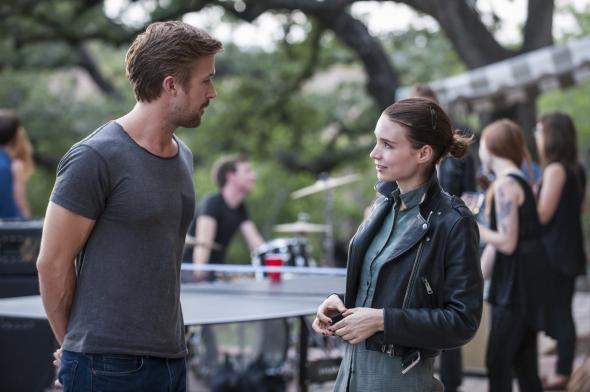With the exception of the cosmologically focused Voyage of Time, the movies Terrence Malick has made since 2011’s The Tree of Life tend to blur together into one diaphanous whole. Even in the middle of Song to Song, which is apparently the last part of an unofficial trilogy that also includes To the Wonder and Knight of Cups, it’s possible to lose your bearings, to remember scenes from those earlier movies as if they were a part of this one. Given that Malick, whose method involves gathering copious footage and finding a story in the editing room, sometimes appropriates shots from one project to use in another, those moments of drift are inevitable, but they’re also revealing. Although the settings and the casts of characters change, these aren’t stories that begin and end so much as lives that we partake of for a time and then take our leave of, cups of water snatched from an ever-flowing river.
That sense that the movies are part of a much larger, undefined whole makes each difficult to reckon with on its own, which is another way of saying that none of them feels entirely complete or individualized. Images recur—a woman’s face pressed up against a window or a wall, the world as seen over a man’s broad shoulders—as do actors, when they survive Malick’s unpredictable postproduction process. Protagonists and narrators shift, as if control of what little story there is were a virus passed from one host to the next.
For convenience’s sake, it’s simplest to describe Song to Song’s main characters as Faye (Rooney Mara), an aspiring musician; BV (Ryan Gosling), a songwriter who’s somewhere in the middle of his own musical career; and Cook (Michael Fassbender), a soul-sucking record-industry bigwig. They form a love triangle of sorts, although at times there are enough other parties involved—Natalie Portman, as a Texas waitress who Cook seduces and marries; Cate Blanchett, as a wealthy, vaguely outlined woman; the singer Lykke Li, as yet another musician and one of BV’s old flames—that it’s more like a love hexagon.
If anyone’s in charge, it’s Faye, who describes herself in airy voice-over as a person “desperate to feel something real … to get through the fence.” Getting through the fence could be an organizing principle for Malick’s movies, where the camera flies across the ground as if gathering speed to smash through an invisible wall, but we also see Faye pressed up against a literal fence at the Austin City Limits music festival, the better to express her desire to go from someone who watches art being created to someone who is watched while she creates. Like the Hollywood figures in Knight of Cups, most of the real-life musicians in Song to Song register only as fleeting presences in the background: Big Freedia twerks, Flea slaps his bass, Iggy Pop gets off a few sentences. (Fortunately, even Terrence Malick knows better than to cut Patti Smith’s big scene.) We see Mara playing an electric guitar in a few shots but never get an idea of what kind of music she might want to make. Cook talks about major-label contracts and record sales, but there’s no hint of the seismic changes that have rocked what is left of the music industry in the past two decades. What interests Malick is the idea of music, not its reality.
Where The Tree of Life and The New World were rooted in Christian theology, the movies since feel like an attempt to seek the divine elsewhere: in nature, in the stars, in love or sex or art. Song to Song keeps on looking, but it’s also run through with the fear that the search may prove a fruitless one. Its ominous opening chords suggest a mood akin to a horror movie; Fassbender was told to model his character on Paradise Lost’s Satan. The sex in Knight of Cups, where the screenwriter played by Christian Bale tried to lose himself in a forest of naked starlets, was playful and adolescent; Malick sometimes seemed more interested in his actresses’ backsides than their fronts. In Song to Song, it’s chaotic, fractured. Sometimes it’s hard to discern which sharp-faced brunette is burying her face in which svelte but muscular man’s neck. Near the beginning of the movie, and also near its end, Mara and Gosling traipse across a rocky hillside and through a puddle of water, and the camera lingers as they scamper out of frame. Malick’s more interested in the ripples they leave behind.
Malick has long been the most publicity-shy of auteurs, but he’s made two relatively high-profile public appearances—his first since the ’70s—in the past several months. At the SXSW Film Festival last week, he was a surprise guest at a Q&A about the film, and last fall, he spoke after a screening of Roberto Rossellini’s My Voyage to Italy at Princeton. No one had seen Song to Song at the latter—he seemed surprised even at a reference to Voyage of Time, which had premiered at Toronto several weeks before—but he was already discussing plans for his next movie, Radegund, which he said would mark a return to a script-driven approach after years of making things up as he went along. Time will tell if he holds to that prediction, but it’s promising that even he seems to feel that this cycle of diffusely visionary, sometimes frustratingly elusive films has run its course. Even at his most indulgent, Malick brings something to the movies that no one else ever has, a way of looking at the world that is easily imitated but has never been equaled. It’s worth sifting through the sometimes half-baked philosophizing and breathy poeticism to see through his eyes.
